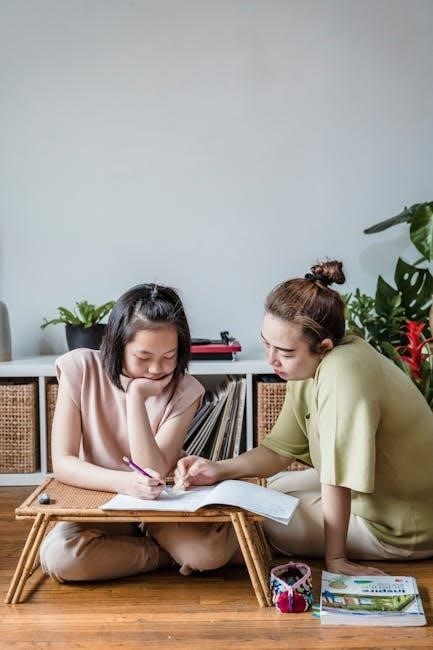
Boondoggle tutorials offer a fun and creative way to craft unique accessories like keychains and bracelets. Also known as scoubidous or lanyards, these crafts are popular worldwide, promoting relaxation and skill development. Perfect for all ages, boondoggles are a great way to express creativity and learn practical crafting skills.
What Are Boondoggles and Their Popularity
Boondoggles, also known as scoubidous or lanyards, are a popular craft involving braiding plastic strips into decorative items like keychains and bracelets. Originating in the 1950s, they gained global appeal, especially among children and teens, due to their simplicity and creativity. The term “boondoggle” often refers to a specific type of braid. Tutorials for these crafts are widely available online, making them accessible to all skill levels. Their popularity stems from their portability and the satisfaction of creating something handmade. Boondoggles have become a cultural phenomenon, with crafting communities and social media further fueling their resurgence. They remain a timeless, enjoyable activity for crafters of all ages.
Why Learn Boondoggle Crafts?
Learning boondoggle crafts is a fun and creative way to develop fine motor skills, hand-eye coordination, and patience. It offers a relaxing hobby that fosters creativity and self-expression. Boondoggle crafts are ideal for all ages, making them a great activity for families or classrooms. They also provide a sense of accomplishment as you create handmade items like keychains, bracelets, and decorations. Additionally, boondoggles are a cost-effective hobby, requiring minimal materials. They encourage offline creativity, helping to reduce screen time and promote focus. Overall, boondoggle crafts are a rewarding and enjoyable way to express yourself artistically while learning a practical skill.

Materials Needed for Boondoggle Crafts
Essential Tools and Supplies
Essential tools and supplies for boondoggle crafts include plastic laces in various colors, scissors for cutting, and a comb for tightening stitches. Perfect for creative projects.
To begin boondoggle crafts, you’ll need a few basic tools and supplies. Plastic laces, available in various colors, are the primary material for creating patterns; A pair of sharp scissors is essential for cutting the laces to the desired length. A comb or a specialized boondoggle tool helps tighten stitches and achieve a neat finish. Optional items include beads for embellishments and a clipboard to keep your work organized. These tools are widely available and inexpensive, making boondoggle crafting accessible to everyone. Having these essentials ready ensures a smooth and enjoyable creative process for both beginners and experienced crafters alike.
Alternative Materials for Creative Projects
While plastic laces are traditional, boondoggle crafts can be made with alternative materials for unique textures and styles. Yarn, fabric strips, or even paper strips can be used, offering a handmade touch. Embroidery floss is another popular choice, providing durability and vibrant colors. Rubber bands or elastic cords can add flexibility to designs. For eco-friendly options, recycled materials like old t-shirt strips or ribbon scraps work well. These alternatives allow crafters to experiment with different looks and themes, making each project distinctive. Whether using traditional or unconventional materials, the creative possibilities remain endless, encouraging innovation and personalization in every boondoggle design.

Step-by-Step Guide to Basic Boondoggle Tutorials
Starting with basic stitches, boondoggle tutorials guide you through creating simple designs. Gather essential tools, practice fundamental knots, and gradually build confidence in your crafting skills.
Starting Your First Boondoggle Project
Welcome to the world of boondoggles! Starting your first project is an exciting step. Begin by gathering essential materials like plastic laces, scissors, and a comb. Choose a simple design, such as a keychain or bracelet, to build confidence. Cut laces to the desired length and set up your base. Start with basic stitches, gradually refining your technique. Don’t worry if initial attempts seem uneven—practice improves skill. Explore tutorials for guidance and troubleshoot common issues like uneven tension. Patience and creativity will help you master this craft. Boondoggles are not only fun but also a great way to relax and create personalized accessories.
Mastering Basic Stitches and Patterns
Mastering basic stitches is the foundation of boondoggle crafting. Start with the Forward-Backward stitch, a simple yet versatile pattern. Practice the Crisscross stitch for a sleek design. Begin with short, manageable projects to build confidence. Keep tension even to avoid unevenness. Use a comb to tighten stitches for a polished look. As you progress, experiment with combinations like the Double Spiral or Zipper Stitch. Watch tutorials for visual guidance, such as the popular Double Spiral tutorial or the Pineapple Stitch video. Consistent practice will refine your skills, allowing you to transition smoothly to intricate patterns. Enjoy the creative process and have fun crafting unique designs!

Advanced Boondoggle Techniques
Advanced techniques introduce complex designs and patterns, enabling crafters to create intricate and visually striking pieces. Incorporate beads and embellishments for added flair and sophistication. Mastering these skills enhances creativity and precision, allowing for professional-quality results and endless customization possibilities.
Creating Complex Designs and Patterns
Mastering complex designs and patterns in boondoggle crafts involves experimenting with advanced stitches, layering, and intricate weaving techniques. By combining different stitches like the pineapple and zipper stitch, crafters can create visually striking designs. These patterns often require precision and patience, as they involve multiple strands and careful planning. Incorporating beads or other embellishments can add depth and texture to the design. Advanced techniques also allow for the creation of spiral and wave patterns, which can be combined to form unique and elaborate designs. With practice, crafters can achieve professional-quality results, making their boondoggle creations truly stand out as personalized and artistic accessories.
Incorporating Beads and Other Embellishments
Incorporating beads and other embellishments into boondoggle crafts adds a personalized touch and enhances the visual appeal of your projects. Beads can be threaded onto the strands before or during weaving, creating intricate patterns and textures. Experiment with different bead sizes, shapes, and colors to match your design. For a polished look, space beads evenly or cluster them for a bold statement. Sequins, charms, and other small decorations can also be added to give your boondoggle a unique flair. When using beads, ensure they fit snugly without disrupting the stitch flow. This technique allows crafters to create one-of-a-kind accessories that reflect their personal style and creativity.
Fixing Uneven Stitches and Tension Issues
Uneven stitches and tension issues are common challenges in boondoggle crafts. To fix them, gently loosen or tighten specific strands to balance the weave. Use a needle or hook to adjust stitches without puckering the material. Practice consistent tension by pulling strands evenly while weaving. For stubborn unevenness, unravel and re-weave the problematic section. Patience is key, as adjusting stitches requires careful manipulation. Regularly checking your work and making minor adjustments will help maintain a smooth, professional finish. Over time, your stitches will become more uniform with practice and attention to detail.
Recovering from Common Errors
Recovering from common errors in boondoggle crafts requires patience and attention to detail. If you notice a mistake, stop immediately to avoid complicating the issue. Gently unravel the stitches back to the point of error, ensuring not to damage the material. Re-weave carefully, following the pattern step-by-step. For miscounted loops or uneven tension, adjust by loosening or tightening specific strands. Use a needle or hook to guide strands back into place. Practice makes perfect, so don’t be discouraged by setbacks. Keep a steady hand and focus on each stitch to restore your project to its intended design. This process refines your skills and ensures a polished finish.
Boondoggle Tutorials for Specific Projects
Boondoggle tutorials for specific projects guide you in creating unique accessories like keychains and bracelets. These step-by-step guides are perfect for expressing creativity and developing crafting skills.
How to Make a Boondoggle Keychain
To make a boondoggle keychain, start by gathering materials like plastic laces, a keyring, and scissors. Begin with a basic stitch, such as the double wrap or pineapple stitch, to create the foundation. Weave the laces step-by-step, ensuring tight and even tension for a neat finish. Once the desired length is achieved, secure the ends to the keyring. Customize by experimenting with different patterns or colors. This project is ideal for beginners, promoting creativity and fine motor skills. With practice, you can craft unique and personalized keychains perfect for everyday use or gifts.
Creating a Custom Boondoggle Bracelet
Creating a custom boondoggle bracelet is a rewarding craft that allows for personalization. Start by measuring your wrist to determine the length of the bracelet. Use plastic laces or gimp strings in your favorite colors to begin the foundation stitch, such as the basic forward and backward wrap. As you progress, experiment with patterns like the pineapple or spiral stitch for a unique design. Add beads or charms for embellishment. Once the desired length is reached, secure the ends with a clasp or knot. This versatile craft can be tailored to suit any style, making it perfect for gifts or personal wear.

Resources for Further Learning
Explore video tutorials on YouTube for step-by-step guides. Visit crafting websites for detailed patterns and written instructions. Check forums and blogs for tips and inspiration.
Recommended Video Tutorials
YouTube offers an abundance of step-by-step boondoggle tutorials for all skill levels. Channels like Cassie’s Crafts provide clear instructions for beginners, such as her popular “2-Strand Boondoggle Tutorial.” Violet’s Tutorials share detailed guides on mastering basic stitches and creating intricate designs. These videos are perfect for understanding techniques like the zipper stitch, spiral patterns, and finishing methods. Many tutorials are designed for kids and adults alike, making them a great resource for family crafting sessions. Whether you’re making keychains or bracelets, these videos offer a visual and engaging way to learn and improve your boondoggle skills. Start crafting with confidence!
Best Written Guides and Patterns
For those who prefer detailed written instructions, there are excellent guides available online. Websites like howviolet.com offer comprehensive step-by-step tutorials, perfect for mastering stitches like the zipper or spiral pattern. Violet’s eBook, “5 Beginner Stitches for Lanyard, Boondoggle, Scoubidou,” is a must-have for newcomers. Platforms like scoubidous.eu provide clear diagrams and patterns for intricate designs. These guides often include tips for troubleshooting common mistakes and offer variations for customization. Whether you’re creating keychains or bracelets, these written resources ensure you can follow along at your own pace and achieve professional-looking results. They’re ideal for crafters who prefer learning through text and visuals.
Boondoggle crafting is a rewarding hobby that combines creativity with relaxation. With practice, you can master various stitches and create unique accessories. Keep experimenting and enjoying the process!
Final Tips for Perfecting Your Boondoggle Skills
Mastering boondoggle crafts requires patience and consistent practice. Start with simple stitches and gradually move to complex patterns. Use high-quality materials for better results. Watch tutorials for visual guidance and experiment with different colors to make your designs unique. Maintain even tension while weaving to avoid loose or tight stitches. Don’t hesitate to undo and redo sections to achieve perfection. Join crafting communities for inspiration and tips. Most importantly, embrace mistakes as part of the learning process and enjoy the creative journey. Happy crafting!